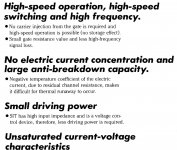Hi Michael and Diyers.
Merci ça va très bien. Formidable 🙂
Very rare to see sit's Tokin big chips how they look like inside.
World premiere exposition in diy universe its a chance.
Mike you say good parts and good parts again this time its clearly optimistic about 182ES
and between 0 to 40 v they have some similar parameters of Pass SIT-1.
Woow sensational let´s look at for Tokins refurbished from fish finders 😉
Ok load lines in next Lab Hangout learning don't stop
Any comments on Tokin datasheet interesting points ?
and next question : what influence of turn on/off switching time in micro seconds ?
Dady's sit's THF 51 have very short 50 micro seconds and 180, 182 five times more.
Thanks again for such great work Michael.
Best regards to all Diy Audio Gentlemans.
Christophe
Attachments
Last edited:
Mike you say good parts and good parts again this time its clearly optimistic about 182ES
Yes, much more optimistic, now that I know what they really look like. 🙂
I guess, Christophe, my friend, that you have to build a lamp-amp with the 182. Make a 12volt DC easy variable-reliable source. Get some lamps, we got 500watt in 125volts, old incandescent lamps (look for in old electricity stores, they have from some time ago when the power was 125volts. Make a bench imitating the Michael one, with a piece of wood. A heater sink fixed with or without isolation from the transistor. Start with 12 volts in gate. 50 volt 2 amps power supply, better if you have a variac, its useful for plenty of works you going to make in the future. Start to burn your things, making mistakes by trial error you will learn. And a soon you have the lamp-amp working connect music to it.
Low impedance source. A french bird told me that you have high sensitive loudspeakers you going to find your sweet spot soon, or later but is a simple circuit but reliable. I am learning like you. I making the mine in these days while the master is showing his goods to us. Camon Soundhappy. We are waiting for your amps and watts news from Montpelier.
Low impedance source. A french bird told me that you have high sensitive loudspeakers you going to find your sweet spot soon, or later but is a simple circuit but reliable. I am learning like you. I making the mine in these days while the master is showing his goods to us. Camon Soundhappy. We are waiting for your amps and watts news from Montpelier.
A bit irrelevant but not really: Did you noticed the price trend of 2sk182es lately?
Last week, I was ready to byu 2 pairs from that Jap guy but now these SITs seem to heading towards unobtanium class...way out of my league😡
Last week, I was ready to byu 2 pairs from that Jap guy but now these SITs seem to heading towards unobtanium class...way out of my league😡
I noticed. He sells them cheaper in 10 piece lots if you can get a group together.
Otherwise, the 180's are usually cheaper and comparable (a bit less gain, but lower capacitance, 300W)
Have patience and something interesting will pop up.
Otherwise, the 180's are usually cheaper and comparable (a bit less gain, but lower capacitance, 300W)
Have patience and something interesting will pop up.
Now is anyone going to shell out for the more expensive 2sk182 device ?
At about $100 each that lets me out besides it would be a pain to mount.
At about $100 each that lets me out besides it would be a pain to mount.
#4
Dear Michael,
watched now also your lab video #4, had fun doing so and learned again something! You have a gift to explain things in clear words. Great!
Thanks for your effort in teaching us via U-tube.
Ulrich
Dear Michael,
watched now also your lab video #4, had fun doing so and learned again something! You have a gift to explain things in clear words. Great!
Thanks for your effort in teaching us via U-tube.
Ulrich
Thanks again Michael!
Does the Miller effect actually account for the high capacitance seen in the 182s? My understanding was that the effect was due to feedback.
Does the Miller effect actually account for the high capacitance seen in the 182s? My understanding was that the effect was due to feedback.
Much appreciated.
The capacitance measured in the video is the effective input capacitance, that is the capacitance you will actually need to deal with in a common source amp stage.
The Miller capacitance is equal to the Drain-Gate capacitance multiplied by the stage gain +1.
The input capacitance of the gain stage is: Cin = Cgs + Cgd*(A+1)
So, if Ggd is already large, say a few thousand pf, and the voltage gain is also large, the capacitance you'll be working with can get pretty big, then you start looking for your high frequencies. 🙂
Measuring the interelectrode capacitances directly is usually done with a capacitance bridge and it looks rather tedious, even for me. I don't bother with that, because I'm not generally concerned with the specifics, just the aggregate effect.
Did that help any?
The capacitance measured in the video is the effective input capacitance, that is the capacitance you will actually need to deal with in a common source amp stage.
The Miller capacitance is equal to the Drain-Gate capacitance multiplied by the stage gain +1.
The input capacitance of the gain stage is: Cin = Cgs + Cgd*(A+1)
So, if Ggd is already large, say a few thousand pf, and the voltage gain is also large, the capacitance you'll be working with can get pretty big, then you start looking for your high frequencies. 🙂
Measuring the interelectrode capacitances directly is usually done with a capacitance bridge and it looks rather tedious, even for me. I don't bother with that, because I'm not generally concerned with the specifics, just the aggregate effect.
Did that help any?
What the heck, if you still want to spitball Ciss, then let's first assume that Cgd and Cgs are roughly symmetrical in these parts.
Then:
14,000 = X + X(5.6+1)
14,000 = 7.6X
1842 = X
So, Ciss is twice that or 3684pf. Of course, that and $5.00 won't get you a coffee at Starbuck's, and what really matters to fearless amp builders is the effective capacitance.
Then:
14,000 = X + X(5.6+1)
14,000 = 7.6X
1842 = X
So, Ciss is twice that or 3684pf. Of course, that and $5.00 won't get you a coffee at Starbuck's, and what really matters to fearless amp builders is the effective capacitance.
Did that help any?
Yup, big SIT chips just mean big capacitance at the input. I guess I am still justifying all the "small" 2SK180s I bought!🙂
Either way the capacitance doesn't really matter much to me. My buffer is strong. A little wiggle room on bandwidth is always nice though.
Edit:
My vote (if it counts for anything) is to skip straight to the top secret stuff!
-Greedy Boy
Last edited:
There's no need to justify your 180's, they're great parts. I just bought a few more myself. Of course the 180's aren't immune to Mr. Miller either, but they have lower intrinsic capacitance and less gain, so he doesn't have quite as much to say.
They all have their virtues. 🙂
P.S. soundhappy's datasheet says Ciss is 2500pf on the 182E. I could have saved myself the algebra. 🙂
They all have their virtues. 🙂
P.S. soundhappy's datasheet says Ciss is 2500pf on the 182E. I could have saved myself the algebra. 🙂
Last edited:
They all have their virtues. 🙂
P.S. soundhappy's datasheet says Ciss is 2500pf on the 182E. I could have saved myself the algebra. 🙂
This datasheet was directly from Maxonic Sibatec
great guys i find it in email

Anyway nothing better like mesurement on bench.
Maxonic company produce high fidelity amplifiers with 182ES .
Tubes and big Sit's OTL mmm yum yum 😀
I guess, Christophe, my friend, that you have to build a lamp-amp with the 182. Make a 12volt DC easy variable-reliable source. Get some lamps, we got 500watt in 125volts, old incandescent lamps (look for in old electricity stores, they have from some time ago when the power was 125volts. Make a bench imitating the Michael one, with a piece of wood. A heater sink fixed with or without isolation from the transistor. Start with 12 volts in gate. 50 volt 2 amps power supply, better if you have a variac, its useful for plenty of works you going to make in the future. Start to burn your things, making mistakes by trial error you will learn. And a soon you have the lamp-amp working connect music to it.
Low impedance source. A french bird told me that you have high sensitive loudspeakers you going to find your sweet spot soon, or later but is a simple circuit but reliable. I am learning like you. I making the mine in these days while the master is showing his goods to us. Camon Soundhappy. We are waiting for your amps and watts news from Montpelier.
@ Dady
Yes i was charmed by L'Amp 2SK180 song & bulbs glow.
Next thing like newbies do i was in entusiasm to try too many projects in parallel
for example last week i finalised F4, F5 and Aleph J
stuffing completly boards with components youpii is ready
so must think some psu's for this now.
CSX-1 Papa Sony are next , pcb´s wait on table with complementary vfets.
Btw last weekend i negociated anodise heat sinks in factory for Michael new Tokin amplifier i want diy.
Patience help a lot and step by step projects become real amplifiers and bring us joy in everyday life.
24 hours is to short.
Yes let's do it class A amplifiers with solid state triodes 🙄
Gracias Amigo Dady
Have a nice day 🙂
Just bite the bullet and ordered some 180 and 182s from Mr. eyelabo, before they dried out. If the eBay history are to be trusted, the price for these SITs almost doubled just in a couple months - probably due to this thread 🙄
My vote (if it counts for anything) is to skip straight to the top secret stuff!
Yoda says: mmmm, secrets, yes, in time, but Mikey's secrets aren't as fun as Sea Ranch secrets.
Attachments
That mean Michael are aware something about Sea Ranch ones 😀
Good news is much more enjoyable if wait time....

Good news is much more enjoyable if wait time....


- Status
- Not open for further replies.
- Home
- Amplifiers
- Pass Labs
- Live Lab Hangout #1.1 Posted


